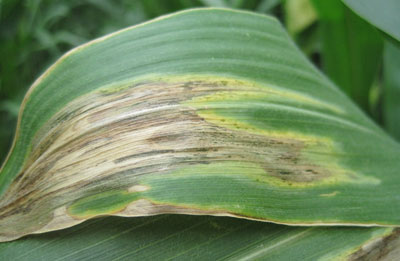Reports of Goss’s wilt have been coming in hard and fast this past week. The disease appears to be widespread north of I-80. Despite the hot, dry weather, the disease has progressed rapidly in the field.
|
|
Syngenta officials reported that growers across Illinois are seeing corn plants dying early due to a severe outbreak of Goss's bacterial wilt. Cases have also been confirmed in areas of Iowa, southern Minnesota and Nebraska.
“This is the first time that we have seen Goss’s wilt in Illinois this wide spread this early,” says Syngenta agronomist Todd Thumma. “Goss’s wilt has typically been more prevalent in the western Corn Belt, but until now it had been very sporadic in Illinois.
“This is a persistent and economically serious disease with potentially devastating results which highlights the need for growers’ in affected areas to plant proven Goss’s wilt tolerant hybrids.”
Goss’s wilt is often misdiagnosed as drought stress or other foliar diseases, especially in areas where it is not typically prevalent. Symptoms of Goss’s wilt include gray to tan lesions on the leaves that follow the leaf veins with small dark green or black “freckles” within the infections.
Another telltale sign is a glossy appearance to the affected leaves, due to bacterial exudates. It is often more of an issue in continuous corn, but can be seen in rotated fields as well.
Once Goss’s wilt is present in a grower’s field, it will always be present and with suitable environmental conditions can recur in following seasons. Therefore, planting hybrids that are Goss’s-wilt tolerant can manage the disease, since it is bacterial and cannot be treated with fungicide. Rotating crops and using pre-emergence herbicides can help reduce occurrences.
Iowa State University will be monitoring disease progress in this field collecting data to calculate yield loss estimates. With grain prices so high, it’s difficult to watch a disease come in and rob yield. Not surprisingly, growers are looking for anything to protect yield potential.
ISU is aware of three products that grower’s are trying, and have had questions regarding their efficacy against Goss’s wilt. Procidic is advertised as a broad spectrum fungicide and bactericide. The active ingredient is citric acid. There is no published data that ISU is aware of for Procidic. Plant Disease Management Reports contains reports on the effect of citric acid on fungal pathogens of horticultural crops, but has no reports of results against bacterial diseases, and no reports on corn. Procidic is labeled for use in Iowa to control Goss’s wilt.
The field ISU is monitoring in Gilbert has had an application of Procidic, as well as an earlier application of Stratego YLD. Researchers plan to monitor the effect of both products on Goss’s disease development and general plant health.
Another product that has been suggested for use to manage Goss’s wilt is Kocide. Since this product is not labeled for use on corn to manage Goss’s, it should not be used. Korus et al. (2010) evaluated Kocide 3000 and Headline for Goss’s wilt control on two hybrids (one susceptible and one resistant) in Nebraska in 2009.
The trial was inoculated with the Goss’s wilt bacterium at growth stage V6/V7. Treatments were applied six days before inoculation, four hours after inoculation or 24 hours after inoculation. Goss’s wilt disease was slightly reduced on a susceptible hybrid with an application of Kocide 24 hours after inoculation, but no differences in yield were detected between this treatment and the untreated, inoculated control. On the resistant hybrid, no treatment differences were detected.
A third product some growers are trying is also a copper-based product called Intercept. There is very little information available on this product. Apparently it has been used successfully to control citrus canker in Florida. Citrus canker is also caused by a bacterium.
There were also some fields in Iowa that were sprayed with this product in 2010. There is no published information available on the efficacy of Intercept against Goss’s wilt or citrus canker. ISU is aware of a couple of fields that have been sprayed in Iowa, and I will be evaluating those fields for the product’s efficacy.
The university encourages growers trying these products to leave one, preferably more, unsprayed strips in the field and meticulously monitor disease development and collect yield data. The check strips should be left in areas of the field that are representative of the entire field.
Management of Goss’s in 2012
The bacterium that causes Goss’s wilt, Clavibacter michiganensis subsp. nebraskensis, survives in infested crop residue. Therefore recommended management practices include growing resistant hybrids, crop rotation and residue management. Continuous corn production, together with minimum-tillage practices, have in part contributed to the epidemic of Goss’s wilt we are witnessing in 2011. Other factors include susceptible germplasm and stormy weather.

 Typical leaf blight symptoms of Goss’s wilt. (ISU photo)
Typical leaf blight symptoms of Goss’s wilt. (ISU photo)




Post a comment
Report Abusive Comment